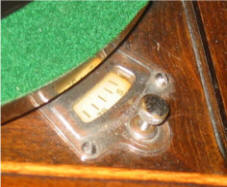The Victor-Victrola Page

How do I set the speed?
ANSWER: One of the most humorous aspects of many YouTube videos featuring Victors or Victrolas, is that the user is totally clueless about setting the correct turntable speed on their phonograph. One will either hear a playback sound similar to "chipmunks" or a slow drunken-sounding moan that puts you to sleep. The speed setting process for the turntable was never considered when the video was made.
 That is what the little speed
control knob is for. In the
early years of the 20th Century, phonograph records varied in recorded speed
from 60 RPM up to 80 RPM; so since there was no "standard" speed, phonograph companies simply allowed the user to set the correct speed for
the record being played. The example on the left is one of many different
designs for speed-control systems that Victor used throughout the years. The
adjustment knob controls the turntable speed, and the dial shows the user
the speed of the turntable. Your machine may not have the dial; it may only
have a single knob or a "fan" type control, depending on vintage and model.
That is what the little speed
control knob is for. In the
early years of the 20th Century, phonograph records varied in recorded speed
from 60 RPM up to 80 RPM; so since there was no "standard" speed, phonograph companies simply allowed the user to set the correct speed for
the record being played. The example on the left is one of many different
designs for speed-control systems that Victor used throughout the years. The
adjustment knob controls the turntable speed, and the dial shows the user
the speed of the turntable. Your machine may not have the dial; it may only
have a single knob or a "fan" type control, depending on vintage and model.
In most cases, after 100 years of use, you can't depend on the accuracy of the readout dial (if you have one) to display the correct speed. They tend to stick or become un-calibrated, which usually requires that some teardown and lubrication of the motor and governor system be performed before it will function correctly. However, unless your motor is totally seized-up or has serious mechanical issues, the speed control adjustment knob will usually work. But you will have to set it manually per the instructions below.
All Victor records should be played at 78 RPM. In order to set the correct speed:
-
Buy an inexpensive turntable strobe, and set the correct speed using the speed-adjustment knob OR
-
Place a piece of paper on the platter and count the number of revolutions that occur during 30 seconds. The correct number should be 78/2 or 39 revolutions. If there are too few revolutions, simply adjust the knob to speed-up the turntable, or if there are too few revolutions, adjust the knob to slow it down. It is an iterative process...you will have to repeat the measurement 4 or 5 times to get it right.
-
If you have a record which was recorded at a different speed (for example, "Silvertone" records were often recorded at 80 RPM), simply divide the required speed by 2 and repeat the steps above.
